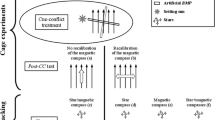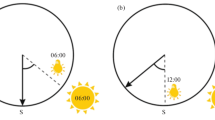Abstract
-
1.
Young migratory birds enter the world with two representations of the migratory direction, one coded with respect to the magnetic field, the other with respect to celestial rotation. The preferred magnetic direction of migratory orientation is malleable early in life: it may be calibrated by celestial rotation, observed either in daytime or at night.
-
2.
Previous experiments showed that early experience with skylight polarization was necessary for calilbration to occur in daytime. In this study, we performed a direct manipulation of patterns of polarized skylight at dawn and dusk.
-
3.
Hand-raised Savannah sparrows (Passerculus sandwichensis) were allowed to observe the clear sky for 1 h prior to local sunrise and for one h following local sunset. They never saw the Sun nor stars. The birds observed the sky through bands of polarizing material (HNP'B) aligned with the e-vector axis in one of three orientations with respect of the azimuth of sunrise and sunset: group 1) 90°; group 2) 45° CW; group 3) 45° CCW.
-
4.
Tested indoors in covered cages in both shifted and unshifted magnetic fields, the autumn migratory orientation of the three groups differed significantly. Group 1 oriented magnetic N-S, group 2 oriented magnetic NW-SE, and group 3 oriented magnetic NNE-SSW. These observed orientation directions are very close to those predicted by the manipulations of polarized skylight.
-
5.
These results indicated that a fairly simplified, static polarized light pattern viewed a limited number of times only in dawn and dusk snapshots is sufficient to produce calibration of the preferred magnetic migratory orientation direction.
Similar content being viewed by others
Abbreviations
- CW :
-
clockwise
- CCW :
-
counterclockwise
- N :
-
north
- E :
-
east
- S :
-
south
- W :
-
west
- mN :
-
magnetic north
References
Able KP (1982) Skylight polarization patterns at dusk influence the migratory orientation of birds. Nature 299: 550–551
Able KP (1989) Skylight polarization patterns and the orientation of migratory birds. J Exp Biol 141: 241–256
Able KP (1991) The development of migratory orientation mechanisms. In: Berthold P (ed) Orientation in birds. Birkhäuser, Basel, pp 166–179
Able KP (1993) Orientation cues used by migratory birds: a review of cue-conflict experiments. Trends Ecol Evol 8: 367–371
Able KP (1994) Magnetic orientation and magnetoreception in birds. Prog Neurobiol 42: 449–473
Able KP, Able MA (1990a) Ontogeny of migratory orientation in the Savannah sparrow, Passerculus sandwichensis: calibration of the magnetic compass. Anim Behav 39: 905–913
Able KP, Able MA (1990b) Calibration of the magnetic compass of a migratory bird by celestial rotation. Nature 347: 378–380
Able KP, Able MA (1993a) Daytime calibration of magnetic orientation in a migratory bird requires a view of skylight polarization. Nature 364: 523–525
Able KP, Able MA (1993b) Magnetic orientation in the Savannah sparrow. Ethology 93: 337–343
Batschelet E (1981) Circular statistics in biology. Academic, New York
Bingman VP (1983) Magnetic field orientation of migratory naive Savannah sparrows with different first summer experience. Behaviour 87: 43–53
Bingman VP, Beck W, Wiltschko W (1985) Ontogeny of migratory orientation: a look at the pied flycatcher, Ficedula hypoleuca. In: Rankin MA (ed) Migration: mechanisms and adaptive significance. Contrib Marine Sci, Suppl, vol 27, Marine Science Institute, Univ Texas, Austin
Brines ML (1980) Dynamic patterns of skylight polarization as clock and compass. J Theoret Biol 86: 507–512
Cherry JD, Able KP (1986) An alternative method for the analysis of Emlen funnel data. Auk 103: 225–227
Emlen ST (1970) Celestial rotation: its importance in the development of migratory orientation. Science 170: 1198–1201
Emlen ST, Emlen JT (1966) A technique for recording migratory orientation of captive birds. Auk 83: 361–367
Goddard SM, Forward RB (1991) The role of the underwater polarized light pattern, in sun compass navigation of the grass shrimp, Palaemonetes vulgaris. J Comp Physiol A 169: 479–491
Helbig AJ (1990) Depolarization of natural skylight disrupts orientation of an avian nocturnal migrant. Experientia 46: 755–758
Helbig AJ (1991) Dusk orientation of migratory European robins, Erithacus rubecula: the role of sun-related directional information. Anim Behav 41: 313–322
Helbig AJ, Wiltschko W (1989) The skylight polarization patterns at dusk affect the orientation behavior of blackcaps, Sylvia atricapilla. Naturwissenschaften 76: 227–229
Kirschvink JL (1992) Uniform magnetic fields and doublewrapped coil systems: improved techniques for the design of bioelectromagnetic experiments. Bioelectromagnetics 13: 401–411
Merritt R, Purcell C, Stroink G (1983) Uniform magnetic field produced by three, four, and five square coils. Rev Sci Instruments 54: 879–882
Moore FR (1986) Sunrise, skylight polarization, and the early morning orientation of night-migrating warblers. Condor 88: 493–498
Moore FR, Phillips JB (1988) Sunset, skylight polarization and the migratory orientation of yellow-rumped warblers (Dendroica coronata). Anim Behav 36: 1770–1778
Phillips JB, Moore FR (1992) Calibration of the sun compass by sunset polarized light patterns in a migratory bird. Behav Ecol Sociobiol 31: 189–193
Phillips JB, Waldvogel JA (1982) Reflected light cues generate the short-term deflector-loft effect. In: Papi F, Wallraff HG (eds) Avian navigation. Springer, Berlin, pp 190–202
Phillips JB, Waldvogel JA (1988) Celestial polarized light patterns as a calibration reference for sun compass of homing pigeons. J Theoret Biol 131: 55–67
Prinz K, Wiltschko W (1993) Migratory orientation of pied flycatchers: interaction of stellar and magnetic information during ontogeny. Anim Behav 44: 539–545
Waldvogel JA, Phillips JB (1991) Olfactory cues perceived at the home loft are not essential for the formation of a navigational map in pigeons. J Exp Biol 155: 643–660
Wiltschko W, Baum P, Fergenbauer-Kimmel A, Wiltschko R (1987) The development of the star compass in garden warblers, Sylvia borin. Ethology 74: 285–292
Wiltschko W, Wiltschko R (1991) Magnetic orientation and celestial cues in migratory orientation. In: Berthold P (ed) Orientation in birds. Birkhäuser, Basel, pp 16–37
Author information
Authors and Affiliations
Rights and permissions
About this article
Cite this article
Able, K.P., Able, M.A. Manipulations of polarized skylight calibrate magnetic orientation in a migratory bird. J Comp Physiol A 177, 351–356 (1995). https://doi.org/10.1007/BF00192423
Accepted:
Issue Date:
DOI: https://doi.org/10.1007/BF00192423




